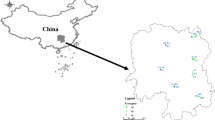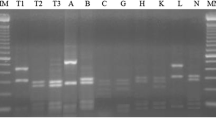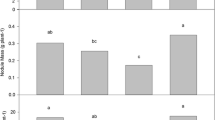Abstract
In this study, soybean nodules were collected from 12 sites in the State of Mato Grosso, in the Brazilian Cerrados, where both exotic soybean [Glycine max (L.) Merrill] and bradyrhizobial strains have been introduced from 1 to 18 years before. All soils were originally devoid of rhizobia capable of effectively nodulating soybean and varied in terms of chemical and physical properties, inoculation procedures, and cropping systems. Rhizobial genetic diversity was assessed on 240 isolates by rep-PCR fingerprinting with BOX primer, and indices of diversity (abundance-based coverage estimator and traditional and modified Shannon indices) were applied to the profiles obtained. The genetic diversity was much greater than expected, as after the introduction of a maximum of four strains, up to 13 profiles were identified, some sharing many similar bands with the inoculant strains, but others quite distinct from the putative parental genotypes. The increase in the number of rep-PCR profiles could be attributed to genetic variability due to the stressful tropical environmental conditions, but also might indicate that indigenous rhizobia become capable of nodulating the host legume. After the third year of cropping with the host legume, inoculation did not affect rhizobial diversity. A high content of clay decreased diversity in comparison with that seen in a sandy soil, probably due to reduced aeration. Diversity was higher under the no-tillage system when compared to the conventional tillage management, highlighting the importance of maintaining crop residues in tropical soils. Understanding the ecology of exotic rhizobia after being introduced into new cropping areas represents a first step towards the establishment of better strategies of inoculation, which in turn may result in sustainability and higher plant yields.


Similar content being viewed by others

References
Alberton O, Kaschuk G, Hungria M (2006) Sampling effects on the assessment of genetic diversity of rhizobia associated with soybean and common bean. Soil Biol Biochem 38:1298–1307
Andrade DS, Hungria M (2002) Maximizing the contribution of biological nitrogen fixation in tropical legume crops. In: Finan TM, O’Brian MR, Layzell DB, Vessey JK, Newton W (eds) Nitrogen fixation, global perspectives. CABI, Wallingford, UK, pp 341–345
Balota EL, Colozzi−Filho A, Andrade DS, Dick RP (2004) Long-term tillage and crop rotation effects on microbial biomass and C and N mineralization in a Brazilian oxisol. Soil Tillage Res 77:137–145
Batista JSS, Hungria M, Barcellos FG, Mendes IC (2006) Variability in Bradyrhizobium japonicum and B. elkanii seven years after introduction of both exotic microsymbiont and the soybean host in a Cerrados soil. Microb Ecol DOI 10.1007/500248-006-9142-2
Bayer C, Mielniczuk J, Martin-Neto L, Ernani PR (2002) Stocks and humification degree of organic matter fractions as affected by no-tillage on a subtropical soil. Plant Soil 238:133–140
Boddey LH, Hungria M (1997) Determination of characteristics of Bradyrhizobium japonicum and B. elkanii species in Brazilian strains which nodulate soybean. Biol Fertil Soils 25:407–415
CBD (The Convention on Biological Diversity) (2002) CBD news supplement: biodiversity and sustainable development. CBD-UNEP, Secretariat of the Convention on Biological Diversity. Retrieved from http://www.biodiv.org/doc/newsletters/news-sd-suplement-en.pdf
CBD (The Convention on Biological Diversity) (2005) Handbook of the convention on biological diversity, 3rd edn. Retrieved from http://www.biodiv.org/convention/default.shtml
Chao A, Lee SM (1992) Estimating the number of classes via sample coverage. J Am Stat Assoc 87:210–217
Chao A, Shen TJ (2003) Nonparametric estimation of Shannon’s index of diversity when there are unseen species in sample. Environ Ecol Stat 10:429–443
Chao A, Shen TJ (2005) Program SPADE (Species Prediction And Diversity Estimation). Program and user’s guide. Retrieved from http://chao.stat.nthu.edu.tw
Chao A, Chazdon RL, Colwell RK, Shen TJ (2005) A new statistical approach for assessing similarity of species composition with incidence and abundance data. Ecol Lett 8:148–159
Chen LS, Figueredo A, Pedrosa FO, Hungria M (2000) Genetic characterization of soybean rhizobia in Paraguay. Appl Environ Microbiol 66:5099–5103
CONAB (Companhia Nacional de Abastecimento) (2005) Safras 1990/91 a 2004/05—Séries Históricas. Retrieved from http://www.conab.gov.br/download/safra/sojaserichist.xls
de Bruijn FJ (1992) Use of repetitive (repetitive extragenic palindromic and enterobacterial repetitive intergeneric consensus) sequences and the polymerase chain reaction to fingerprint the genomes of Rhizobium meliloti isolates and other soil bacteria. Appl Environ Microbiol 58:2180–2187
de Oliveira VM, Manfio GP, Coutinho HLC, Keijzer-Wolters AC, van Elsas JD (2006) A ribosomal RNA gene intergenic spacer based PCR and DGGE fingerprinting method for the analysis of specific rhizobial communities in soil. J Microbiol Methods 64:366–379
Ferreira MC, Hungria M (2002) Recovery of soybean inoculant strains from uncropped soils in Brazil. Field Crops Res 79:139–152
Ferreira MC, Andrade DS, Chueire LMO, Takemura SM, Hungria M (2000) Tillage method and crop rotation on the population sizes and diversity of bradryhizobia nodulating soybean. Soil Biol Biochem 32:627–637
Franchini JC, Crispino CC, Souza RA, Torres E, Hungria M (2006) Microbiological parameters as indicators of soil quality under various tillage and crop-rotation systems in southern Brazil. Soil Tillage Res DOI 10.1016/j.still.2005.12.010
Galli-Terasawa LV, Glienke-Blanco C, Hungria M (2003) Diversity of a soybean rhizobial population adapted to a Cerrados soil. World J Microbiol Biotechnol 19:933–939
Germano MG, Menna P, Mostasso FL, Hungria M (2006) RFLP analysis of the rRNA operon collection of bradyrhizobial strains from 33 legume species. Int J Syst Evol Microbiol 56:217–229
Goedert WJ (1983) Management of the Cerrado soils of Brazil: a review. J Soil Sci 34:405–428
Grange L, Hungria M (2004) Genetic diversity of indigenous common bean (Phaseolus vulgaris) rhizobia in two Brazilian ecosystems. Soil Biol Biochem 36:1389–1398
Hungria M, Vargas MAT (2000) Environmental factors affecting N2 fixation in grain legumes in the tropics, with an emphasis on Brazil. Field Crops Res 65:151–164
Hungria M, Nishi CYM, Cohn J, Stacey G (1996) Comparison between parental and variant soybean Bradyrhizobium strains with regard to the production of lipochitin nodulation signals, early stages of root infection, nodule occupancy, and N2 fixation. Plant Soil 186:331–341
Hungria M, Boddey LH, Santos MA, Vargas MAT (1998) Nitrogen fixation capacity and nodule occupancy by Bradyrhizobium japonicum and B. elkanii strains. Biol Fertil Soils 27:393–399
Hungria M, Franchini JC, Campo RJ, Graham PH (2005a) The importance of nitrogen fixation to soybean cropping in South America. In: Werner D, Newton WE (eds) Nitrogen fixation in agriculture, forestry, ecology and the environment. Series: nitrogen fixationin agriculture, forestry, ecology, and the environment. Springer, Berlin Heidelberg New York, pp 25–42
Hungria M, Loureiro MF, Mendes IC, Campo RJ, Graham PH (2005b) Inoculant preparation, production and application. In: Werner D, Newton WE (eds) Nitrogen fixation in agriculture, forestry, ecology and the environment. Series: nitrogen fixation in agriculture, forestry, ecology, and the environment. Springer, Berlin Heidelberg New York, pp 223–253
Hungria M, Campo RJ, Mendes IC, Graham PH (2006) Contribution of biological nitrogen fixation to the N nutrition of grain crops in the tropics: the success of soybean (Glycine max L. Merr.) in South America. In: Singh RP, Shankar N, Jaiwal PK (eds) Focus on plant agriculture: 1. nitrogen nutrition in plant productivity. Studium Press LLC, Houston, USA, pp 43–93
Jaccard P (1912) The distribution of flora in the alpine zone. New Phytol 11:37–50
Kaschuk G, Hungria M, Andrade DS, Campo RJ (2006a) Genetic diversity of rhizobia associated with common bean (Phaseolus vulgaris L.) grown under no-tillage and conventional systems in Southern Brazil. Appl Soil Ecol 32:210–220
Kaschuk G, Hungria M, Santos JCP, Berton-Junior JF (2006b) Differences in common bean rhizobial populations associated with soil tillage management in southern Brazil. Soil Tillage Res 87:205–207
Kennedy AC (1999) Bacterial diversity in agroecosystems. Agric Ecosyst Environ 74:65–76
Kennedy AC, Smith KL (1995) Soil microbial diversity and the sustainability of agricultural soils. Plant Soil 170:75–86
Loreau M, Naeem S, Inchausti P, Bengtsoom J, Grime JP, Hector A, Hooper DU, Huston MA, Raffaelli D, Schmid B, Tilman D, Wardle DA (2001) Biodiversity and ecosystem functioning: current knowledge and future challenges. Science 294:804–808
Mendes IC, Hungria M, Vargas MAT (2004). Establishment of Bradyrhizobium japonicum and B. elkanii strains in a Brazilian Cerrado oxisol. Biol Fertil Soils 40:28–35
Nishi CYM, Boddey LH, Vargas MAT, Hungria M (1996) Morphological, physiological and genetic characterization of two new Bradyrhizobium strains recently recommended in Brazilian commercial inoculants for soybean. Symbiosis 20:147–162
Pavan MA, Bloch MF, Zempulski HD, Miyazawa M., Zocoler DC (1992) Manual de Análise Química do Solo e Controle de Qualidade. IAPAR, Londrina, Brazil, p 40 (Circular 76)
Santos MA, Vargas MAT, Hungria M (1999) Characterization of soybean Bradyrhizobium strains adapted to the Brazilian savannas. FEMS Microbiol Ecol 30:261–272
Shannon CE, Weaver W (1949) The mathematical theory of communication. University Illinois Press, Urbana, USA, p 117
Shen TJ, Chao A, Lin JF (2003) Predicting the number of new species in further taxonomic sampling. Ecology 84:798–804
Sneath PHA, Sokal RR (1973) Numerical taxonomy. Freeman, San Francisco, USA, p 573
Sprent JI (1994) Evolution and diversity in the legume–Rhizobium symbiosis: chaos teory? Plant Soil 161:1–10
Streeter JG (1994) Failure in inoculant rhizobia to overcome the dominance of indigenous strains for nodule formation. Can J Microbiol 40:513–522
Sullivan JT, Ronson CW (1995) Evolution of rhizobia by acquisition of a 500-kb symbiosis island that integrates into a phe-tRNA gene. Proc Natl Acad Sci USA 95:5145–5149
Sullivan JT, Patrick HN, Lowther WL, Scott DB, Ronson CW (1995) Nodulating strains of Rhizobium loti arise through chromosomal symbiotic gene transfer in the environment. Proc Natl Acad Sci USA 92:8985–8989
Sullivan JT, Eardly BD, van Berkum P, Ronson CW (1996) Four unnamed species of nonsymbiotic rhizobia isolated from the rhizosphere of Lotus corniculatus. Appl Environ Microbiol 62:2817–2825
Versalovic J, Schneider M, de Bruijn F, Lupski JR (1994) Genomic fingerprinting of bacteria using repetitive sequence-based polymerase chain reaction. Methods Mol Cell Biol 5:25–40
Vincent JM (1970) Manual for the practical study of root nodule bacteria. IBP handbook 15, Blackwell, Oxford, UK, p 164
Acknowledgements
The authors thank Ligia Maria O. Chueire, Rinaldo B. Conceição, and Fábio L. Mostasso (Embrapa Soja) for help in several steps of this work and to Dr. Allan R.J. Eaglesham for helpful suggestions on the manuscript. Research described herein was partially supported by CNPq (Conselho Nacional de Desenvolvimento Científico e Tecnológico, Brazil)—projects PRONEX and Instituto do Milênio—and Fundação Araucária (046/2003). M.F. Loureiro (150119/01-1) and M. Hungria (301241/2004-0) acknowledge fellowships from CNPq.
Author information
Authors and Affiliations
Corresponding author
Rights and permissions
About this article
Cite this article
Loureiro, M., Kaschuk, G., Alberton, O. et al. Soybean [Glycine max (L.) Merrill] rhizobial diversity in Brazilian oxisols under various soil, cropping, and inoculation managements. Biol Fertil Soils 43, 665–674 (2007). https://doi.org/10.1007/s00374-006-0146-x
Received:
Revised:
Accepted:
Published:
Issue Date:
DOI: https://doi.org/10.1007/s00374-006-0146-x



